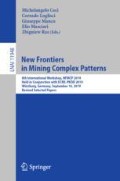Abstract
The interpretability of Graph Convolutional Neural Networks is significantly more challenging than for image based convolutional networks, because graphs do not exhibit clear spatial relations between their nodes (like images do). In this paper we propose an approach for estimating the discriminative power of graph nodes from the model learned by a deep graph convolutional method. To do this, we adapt the Grad-CAM algorithm by replacing the part which heavily relies on the 2D spatial relation of pixels in an image, with an estimate of the node importance by its appearance count in the result of the Grad-CAM. Our strategy was initially defined for a real-world problem with relevant domain-specific assumptions; thus, we additionally propose a methodology for systematically generating artificial data, with similar properties as the real-world data, to assess the generality of the learning process and interpretation method. The results obtained on the artificial data suggest that the proposed method is able to identify informative nodes for classification from the deep convolutional models.
Access this chapter
Tax calculation will be finalised at checkout
Purchases are for personal use only
References
Doshi-Velez, F., Kim, B.: Towards a rigorous science of interpretable machine learning. arXiv e-prints, February 2017
Selvaraju, R.R., Das, A., Vedantam, R., Cogswell, M., Parikh, D., Batra, D.: Grad-CAM: why did you say that? Visual explanations from deep networks via gradient-based localization. CoRR abs/1610.02391 (2016)
Molnar, C.: Interpretable machine learning (2019). https://christophm.github.io/interpretable-ml-book/
Greenwell, B.M., Boehmke, B.C., McCarthy, A.J.: A simple and effective model-based variable importance measure (2018)
Zhao, Q., Hastie, T.: Causal interpretations of black-box models (2019)
Fisher, A., Rudin, C., Dominici, F.: All models are wrong but many are useful: variable importance for black-box, proprietary, or misspecified prediction models, using model class reliance. arXiv e-prints, January 2018. arXiv:1801.01489
Goldstein, A., Kapelner, A., Bleich, J., Pitkin, E.: Peeking inside the black box: visualizing statistical learning with plots of individual conditional expectation. J. Comput. Graph. Stat. 24(1), 44–65 (2015)
Štrumbelj, E., Kononenko, I.: Explaining prediction models and individual predictions with feature contributions. Knowl. Inf. Syst. 41(3), 647–665 (2014)
Ribeiro, M.T., Singh, S., Guestrin, C.: “Why should I trust you?”: explaining the predictions of any classifier. CoRR abs/1602.04938 (2016)
Zeiler, M.D., Fergus, R.: Visualizing and understanding convolutional networks. CoRR abs/1311.2901 (2013)
Simonyan, K., Vedaldi, A., Zisserman, A.: Deep inside convolutional networks: visualising image classification models and saliency maps. CoRR abs/1312.6034 (2013)
Springenberg, J., Dosovitskiy, A., Brox, T., Riedmiller, M.: Striving for simplicity: the all convolutional net. In: ICLR (Workshop Track) (2015)
Zhou, B., Khosla, A., Lapedriza, A., Oliva, A., Torralba, A.: Learning deep features for discriminative localization. In: CVPR (2016)
Zhang, M., Cui, Z., Neumann, M., Chen, Y.: An end-to-end deep learning architecture for graph classification. In: AAAI, pp. 4438–4445 (2018)
Acknowledgments
This work was supported by a grant from the Romanian National Authority for Scientific Research and Innovation, CNCS-UEFISCDI (project number COFUND-NEURON-NMDAR-PSY), a grant by the European Union’s Horizon 2020 research and innovation program – grant agreement no. 668863-SyBil-AA, and a National Science Foundation grant NSF-IOS-1656830 funded by the US Government.
Author information
Authors and Affiliations
Corresponding authors
Editor information
Editors and Affiliations
Rights and permissions
Copyright information
© 2020 Springer Nature Switzerland AG
About this paper
Cite this paper
Palcu, LD., Supuran, M., Lemnaru, C., Dinsoreanu, M., Potolea, R., Muresan, R.C. (2020). Discovering Discriminative Nodes for Classification with Deep Graph Convolutional Methods. In: Ceci, M., Loglisci, C., Manco, G., Masciari, E., Ras, Z. (eds) New Frontiers in Mining Complex Patterns. NFMCP 2019. Lecture Notes in Computer Science(), vol 11948. Springer, Cham. https://doi.org/10.1007/978-3-030-48861-1_5
Download citation
DOI: https://doi.org/10.1007/978-3-030-48861-1_5
Published:
Publisher Name: Springer, Cham
Print ISBN: 978-3-030-48860-4
Online ISBN: 978-3-030-48861-1
eBook Packages: Computer ScienceComputer Science (R0)


